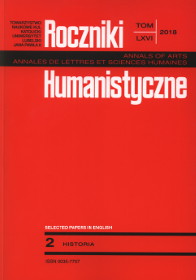Public Penance of Heretics: its Forms and Functions
Public Penance of Heretics: its Forms and Functions
Author(s): Paweł KrasSubject(s): History, Middle Ages, 13th to 14th Centuries
Published by: Towarzystwo Naukowe KUL & Katolicki Uniwersytet Lubelski Jana Pawła II
Keywords: heresy; Inquisition; rituals; penance
Summary/Abstract: The Polish version of the article was published in Roczniki Humanistyczne vol. 59, issue 2 (2011).The article discusses the origins of public penance for heresy in the early Christian tradition as well as examining its application in the penitential practice of the medieval Church. It demonstrates how public penance for mortal sins, which took shape in Late Antiquity, was later adopted and developed within the system of medieval Inquisition. In the medieval collections of canon law, heresy was qualified as a religious crime which required special public penance. Following the guidelines set up in the ancient Church, any heretic who declared his or her intention to renounce their wrongs was to be interrogated by a bishop, who would grant them absolution of sins and prescribed due penance. An important aspect of penance for heresy was public solemn penitence, which took place on Sundays and feast days and included a number of rituals. The penitent heretic had to appear in a special garment with his or her hair cut off and barefoot. The ritual of solemn public penitence for mortal sins was formed in Late Antiquity and as such was later incorporated into medieval pontificals.The rise of medieval Inquisition, which was used as an efficient weapon against popular heresy, stimulated the development of penitential discipline for heretics. Papal Inquisitors, who came to be appointed as extraordinary judges in heresy trials since the 1230s, were particularly inventive in the way how public penance might be employed to fight heretics. Medieval registers of heresy trials, carried out by papal inquisitors and bishops, are still the main source of information about penalties imposed on heretics who were sentenced for their errors. The public announcement of a sentence and penalty was the final act of the inquisitorial procedure. The penitential document (littera penitentialis), which was first read publicly and later handed over to the penitent heretic, listed various forms of penitence which he had to fulfil. In the inquisitorial strategy of penance, which started to be used in the first half of the thirteenth century, a solemn public penitence of heretics became commonplace. The inquisitorial registers and manuals for inquisitors described in detail the ritual of public penance and its functions. The penance imposed on heretics offered them a chance to repent publicly for their public crimes and to give satisfaction to society which had been disturbed by their deeds. That is why solemn public penance usually took place in a cathedral or central market square on feast days to be attended and witnessed by the local community. Through his special appearance and penitential garment with two penitential crosses, the heretic was highly visible and could not be anonymous. The whole society was responsible for supervising the penance of heretics and controlling their religious and moral conduct. Any act of religious transgression or misconduct was to be reported to the ecclesiastical authorities. Of course, public penitence was aimed at teaching a lesson to all the faithful and preventing them from falling into heresy.
Journal: Roczniki Humanistyczne
- Issue Year: 66/2018
- Issue No: 2SP
- Page Range: 57-77
- Page Count: 21
- Language: English

